 Izmir
Izmir
İzmir is Turkey's third largest metropolis after Istanbul and Ankara and fairs center is a contemporary port city integrated with trade.
In the west of İzmir, Çeşme Peninsula stretches by sea, beaches and thermal centers. Ephesus, one of the most famous cities of antiquity, was one of the largest cities in the world during Roman empire. Ephesus, which has all the riches of all Ionian cultures in it, also announced its name with intense artistic activities. For this purpose, this city was called "Güzel İzmir", "Eski İzmir" and "la Perle de l'Ionie" (The Pearl of Ionia). Since then, these definitions have been the subject of the city for many years.
İzmir is located at the beginning of a long narrow bay surrounded by yachts and ships. It has a mild climate and takes a fresh coolness from the sea in summer to take away the heat of the sun. Along the coast are palm trees, palm trees and wide streets. İzmir Port is the biggest port of Turkey after Mersin Port. Izmir, a vibrant and cosmopolitan city, also holds an important place with international art festivals and İzmir International Fair.
Etymology
The word "İzmir" was written in Smyrna in the former Ionian dialect and Smyrna in the Athens dialect. [Today's Hellenes are pronouncing the name of this city in the form of Zmirni, and in recent years it has been found that there is a village settlement called this name in the vicinity of the ancient city of Ephesus. It is thought that a queen who is probably from Izmir to Ephesus also put a keeper who is named after them, and the information about this is also found in the old sources.
The word "Smyrna" is not Greek. Like many settlements in the Aegean region, it is Anatolian origin. Some tablet texts from Kültepe (Kayseri) settlement dating from the beginning of 2000 BC are found in the name of Tismurna. [Citation needed] A prefix of tismurna is probably a person or a place name. Those who hold the Hellenes or the Bayrakli Höyük (2) also call this town the Smyrna.
History
The old city of Smyrna (Smyrna) was built on an island with an area of about 100 acres in the north-east of the gulf. [Citation needed] During the last centuries, the present-day Bornova rubble formed with the mileage of the Meles Stream and the seller from today's Mount Yamanlar, The island is turned into a hill.
Now this mound bearing the name of Tepekule has the sample link of İzmir Wine and Brewery of Tekel Administration. Since 1955, İzmir Höyükü is the first settlement in İzmir. In the first excavations there, the contributions of the Turkish Historical Society and the General Directorate of Antiquities and Masons were great.
The first settlements on the western Anatolian coast - which originate from the Aiol, Ionian and Dorian origins after the Trojan War - are usually built on the small peninsulas. These are settlements such as Pitanes (Çandarlı), Phokaia (Foça), Smyrna (İzmir), Klazomenai (Kilizman), Milet and İasos. Thus, the peninsula residents had both limousines and were assured against attack from the black sea. In bad weather, if one of the ports was not suitable, the shipowners had the chance to use the other port. The Bayraklı Mound was in a comfortable position against the attack from the land, taking the Yamanlar Mountain, which is steeply sloping to the north, in the northeast corner of the bay. Southern imitation was open. Former İzmir settlement has been given on this peninsula for about 3000 years. In the second half of the 4th century BC it moved to the skirts of today's Kadifekale (Pagos) due to the large population increase.
Iron Age: During the Hittite period (1800-1200 BC), writing was being used in Anatolia, and for that reason, the age of history was reached at that time. However, after the destruction of Troika VII and the Hittite capital Hattushas from the Balkans in 1200 BC, Central and Western Anatolia once again entered the Iron Age, an unwritten and dark age. The Iron Age continued in the Kingdom of Phrygia 730 BC with the reuse of the writing in Anatolia and 650 BC in the remaining Central and Western Anatolia.
According to the pottery products found in the excavations, it was understood that during the Iron Age, there were Aiolites and Ions living in the old Greek part of Izmir in the region of Greece. [Citation needed] No evidence was found about the inhabitants of the peninsula. It is understood that the settlement of Bayraklı Höyük, which started to be established in 1050 BC, is of Greek origin.
During this primitive period which lasted for 400 years, five major settlements were identified. These:
1. Aiol settlement (1000 BC-1000 BC)
2. Early, Middle and Late Protogeometric settlements (1000 BC-875 BC)
3. Early and Middle Geometric settlement (875-700 BC)
4. Late Geometric settlement (750 BC-675 BC)
5. Subgeometric settlement (650 BC - 650 BC)
The five layers start at 6,40 meters from the sea and end at 9,50 meters to form a layer 3 meters thick. The Aiol germicide obtained from the excavations is of Submyken origin. In the Protogeometric and Geometric style, we can say that it is a continuation of the Attica vase in general.
During the Iron Age, İzmir houses consisted of large and small one-room buildings. The oldest house to date is dated to 925 BC and 900 BC. This well-preserved one-room house (2.45 x 4 m) was made of mud brick walls and a damascus wall. From the Early Geometric period (875 BC) these one-room houses were turning three sides of a horse-shaped courtyard.
Old Izmirites began to protect their cities with a thick wall made of mudbrick in 850 BC. From this date, it can be said that Old Izmir won a city state identity. It is possible that the city managed a brain called "Basileus". Those who carried out the immigration and the city prominent were the noble group. The population living in the city walls was probably around a thousand people. In the period described with Late Geometric and Subgeometric ceramics (750-650 BC), half the population was crowded and perhaps more than 1500 people. A large part of the people of the city state lived in the surrounding villages. These villages included the fields of Old Izmir, olive trees, vineyards, pottery and masonry workshops in this era. His life was provided by agriculture and fishing.
The most important sacred structure of the city was the Temple of Athena. The oldest surviving remains of this temple are dated to between 725 and 700 BC. In the four previous periods (1050-700 BC) it was most likely worshiped by the goddess Athena, but at that time the sculpture of the goddess was probably in a small niche (naiskos). As it is known, the epic of Homer was written in a duel where the Iliad, Aiol and Ionian dialects were mixed. For this reason, this very important epic work of world history is probably formed in Izmir, the border region where these two speakers are spoken. As a matter of fact, they built a building named 'Homeraion' for Homeros of Hellenistic period İzmir.
The brilliant period of old Izmir corresponds to between 650-545 BC. This period of nearly a century is the most powerful period of all Ionian civilization. In this period, colonies in Pontus (Black Sea) and Propontis (Marmara Region) are established in Egypt, on the western coasts of Syria and Lebanon, and in the East Helen world by competing with continental Greece, It started to take its place in the matter. In this period, we see that İzmir is not content with agriculture and is a partner in Mediterranean trade. Phenomenal artifacts, Cypriot sculptures and statuettes on these floors, tile figurines originating from Asia Minor or Mediterranean origin are the works of this international trade.
One of the important manifestations of the bright period in İzmir has been the spreading of the writing since 650 BC. Many of the gifts presented to the female goddess Athena have inscriptions. Although the number of the people of the city is not much, some of them are literate. The Temple of Athena (640-580 BC) unearthed in excavations is the oldest architectural work of the Eastern Hellenic world. The oldest and most beautiful column headings have been found in İzmir so far. Column headings in Samos, Miletus, Ephesus, Erythrai and Phokaia are not before the second half of the 6th century BC (575-550 BC). They are borrowed from these titles, which are the most original architectural elements of Helkan art, Aiol and Ionian titles and Iyon and Midilli style kymation (leaf or egg-shaped architecture ornamentation) which are sun-shining in Old Izmir and inspired largely from Anatolian Hittite art
The oldest example of the multi-room house type in the Hellenic world was found in Old Izmir. [Citation needed] A two-storey, five-room, front courtyard double "megaron", really built in the second half of the 7th century BC, Old multi-room house. Before that, the Greek houses consisted of "megarons" lined up side by side. The streets and streets of old Izmir were planned to be grilled in the second half of the 7th century, the streets and streets extending from north to south and east to west, the houses were usually looking south.
This city plan, which will take the name of the Hippodamos type in the 5th century BC, was already known in the Near East. The flagship city plan is the earliest example of this kind of city doctrine in the Western world. The oldest paved path of the Ionian civilization was brought to light in Old Izmir.
The oldest civil architectural piece of the Hellenic world is the beautiful stone fountain that was built in the first half of the 7th century in Old Izmir. [Citation needed] The Tantalus mezar, which once erected on the Yamanlar Mountain, is a beautiful representative of tholos shaped monumental tombs. The burial chamber of the Tantalus tumulus was in the plan of the named fountain, and it was in the kind of structure bearing the name "Isopata" type as it is. In other words, the plan was covered with a vault on top and overtopping technique. This monumental work, which is referred to by the name of Tantalos grave, must be the tomb of Basileus or Tyra, who held the administration in Old Izmir between 520-580 BC.
In Old Izmir, pottery workshops produce beautiful examples of ceramics in the archaeological literature called "orientalisan" or "frisian style", stone masons masquerading as sculptures and statues other than architectural works, and part of all these artistic creations were exported to foreign markets.
As it is known, in the first half of the 6th century BC, the cultural center of the ancient world at that time was Western Anatolia. Especially in Miletus, for the first time in history, scientific research based on free thought, liberated from superstitious beliefs and all kinds of religious influences, has begun. By taking advantage of the wealth of knowledge and experience of the Eastern world, and especially by free thinking, nature philosophers such as Thales, Anaksimenes and Anaximandros laid the foundations of today's Western civilization. For the first time in the world, Thales calculated a natural phenomenon before the solar eclipse occurred on May 28, 585 BC. Thus, in the field of culture and science, the leadership that has been in Mesopotamia and Egypt for 2500 years since the beginning of history has passed to Western Anatolia. Western Anatolia maintained its leadership until the year 545 when the Iranians occupied Anatolia. However, when Iranian occupation and philosophers, scientists and artists migrated to Athens, culture and scholarship led to Athens.
Like Miletus, Ephesus and Samos, İzmir was probably one of the leading cities in the field of thought and science in the early 6th century. However, Old Izmir lost its importance in the studies because of the fact that the period was one of the most advanced cultural centers in 640-545 BC and later it lost its significance. There is not enough information about the level of old Izmir in literature, poetry, history, philosophy and science. It was an important center for architecture.
Herodotus refers to the capture of Ancient İzmir by King Lydian Alyattes. [Citation needed] This excavation also dates to 500 BC. Even though the city and the Athena temple were destroyed, the İzmir rebuilt the temple in 590 BC.
The city, which was later occupied by the Persians in the mid-6th century, completed the brilliant period with this event. The fact that there are no gifts of gifts to Athena after this date is one of the important signs of this destruction.
Period of Decline (500-300 BC): Although the Temple of Athena was abandoned in 545 BC, the settlement continued, but after that, about 200 years ago, İzmir lost its importance and function.
The Bayraklı Tumulus, which was a small but rich settlement during the 5th century BC, was a busy settlement at the end of the 5th century BC and especially during the 4th century BC. In this period, three large houses with large courtyards, one with 5, one with 8 and the other with 15 rooms, were brought to light. It is plausible that they belong to the provinces, which are tyrants, as they are in the nearby town of Larissa in accordance with the influence of Persia, which governed the city and possibly during the period. As a matter of fact, a few 4th century tumuli with smooth crêpes that are still partially preserved in the Yamanlar Mountain and which should be the graves of important people support this idea.
In other words, there are small houses with quadrangular plans, many of them from the megalopolis. It can be said that the whole upper level of Bayraklı mound was covered with houses during the 4th century. It is understood that Persian occupation in Anatolia lost its power in the 4th century and caused the growth of the Ionian cities. The new Izmir city was established on the skirts of Kadifekale (Pagos) in 300 BC since the Bayraklı Höyüğü, a hundred thousand acres with the population explosion coming to the plains, started to come to Izmir little.
The Roman Empire Period (133 BC-395 AD): After Alexander the Great defeated Persian King Darius in Issea (333 BC) and seized the entire east from behind, the Hellenic world reached a great prosperity age. Cities became the scene of population explosions. In the Hellenistic period, each of the cities of Alexandria, Rhodes, Bergama and Ephesus reached a population of over 100,000. Only a few thousand people could live in the walls of the old city of Izmir, built on a small hill. For this reason, a new and large city was established at the foot of Kadifekale at 300 BC at the latest.
Izmir (Smyrna in the name of time) passed through the 1st Celevkos, the king of the Seleucids, defeated in the Battle of Corupedion, which was built in 281 BC after Lysimakhos and then Lysimakhos in the civil war, which took place in 323 BC, following the death of Alexander the Great. The Seleucid sovereignty lasted until the Battle of Magnesia (today Manisa), which took place in 190 BC. The Seleucids were given to the kingdom of Pergamum with the Battle of Apameia (today Dinar), which took place two years after this battle lost against the Romans. Bergama's sovereignty continued until the death of King Attalos 3, and at that time, the Romans passed away and bound to the Asian State.
The historian Strabon states that Smyrna was the most beautiful Ionian city during its own time, ie during the 1st century BC transition. At that time a small part of the city was on Kadifekale (Pagos). The large part was gathered around the harbor on flat land. The main goddess's temple and "gymnasion" were also on this line. The streets were flat and all were covered neatly with large stones. Aristeides tells us that there are two main roads in the east-west direction of the city (Sacred road and Golden road) and that the city is cool with the breeze coming from the sea. [Citation needed] Strabon refers to the presence of a stoan called Homereion in Izmir A perystil house). There was a statue of Homer in this house.
Among the constructions built in İzmir in the Roman era, there are few traces from both the ancient theater in the northwest of Kadifekale and the stadium in the west. On the other hand, the Smyrna Agora is well preserved and today it is known as Agora. The Agora measures 120x80 meters in length and has a large courtyard. There were stoas on the east and west. Both buildings were 7,5 m in height and two floors. There was also a basilica of 28 m in length. İzmir entered the rule of the Romans in the 2nd century BC and started to live the golden period for the second time. Although the King of Pontus passed the 6th Mithridates in 88 BC, 2 years later the Romans took the city back.
Smyrna, with the name "Seven Churches" mentioned in the Bible, plays an important role in the development of Christianity. Saint Polikarp apostle and biblical writer, the first archbishop of Izmir He is one of John's first followers. He was born in Anatolia in about 70 AD and was burned by the Romans on 23 February 155 at the stadium on the Izmir acropolis. When the Roman Empire was divided into two in 395 AD, Izmir became part of the Eastern Roman Empire, which would be known as the "Byzantine Empire" in the contemporary era.
During the period of the Eastern Roman Empire: during the period of the Eastern Roman Empire, the Arabs, the Seljuks, the Crusaders and the Genoese battle each other to conquer the city. The city first used it as a base in the rivers that it conquered in Istanbul in the year 672. The Turks seized İzmir for the first time in 1076 at the command of the Seljuk Raiders and Chaka Bey, the first major Turkish sailor in time. After the death of Çaka Bey, who gave fear to the Byzantines with the raids that he had made against the Aegean Islands and the Dardanelles, the Byzantines returned to the city in 1098 and the shore side of the city passed by the Knights of Rhodes in 1204.
In 1310, Aydınoğlu Umur Bey captured the entire city. In 1344 the Genoese gathered on the coast. Peter will take possession. While the Genoese keep the city under control, the Aydınoğulları Principality dominates the upper city (Kadifekale). Gavur İzmir is from that time and it was used to describe the lower city that was in the hands of the Genovese. [Citation needed] This time the city of Peter and the city below is captured by the Knights of Rhodes. Meanwhile, the Ottoman Empire ruled over Izmir in 1398. Timur, who defeated the Ottoman Empire by winning the Ankara War, invaded the Mongol army city, which he himself commanded in 1403, Peter tidies up the floor. This conquest is also important because Timur is the only war against the Christian forces. After the recovery of the Ottoman Empire in 1422 II. Murad captures the city and İzmir becomes part of the Ottoman Empire after that.
The Ottoman Empire Period: The first Ottoman ruler of İzmir, which is a second degree sanjak in the first centuries of the Ottoman administration, is the Hasan Ağa. In the years 1605-1606, in the context of the Jalali revolts, the Arab Sait and Kalenderoglu revolted. However, the city became one of the most important trade centers of the Empire after the capitulations of the Ottoman Empire in 1620 with foreigners.
British in 1619 and British consulates in 1620. Meanwhile, the population structure of the city starts to change. Sources in the 16th century indicate that there are 19 mosques, 18 synagogues and only 1 Greek Orthodox church in Izmir and that only one of the city's 9 districts has Christians. Therefore, Muslim-Turks in the city center in that period mostly have a significant and well-established Jewish community (Sabetay Sevi came out of İzmir Jewish community in the 17th century) and Christian Greeks should be in minority. Evliya Çelebi records the first observations of the change in population structure during his visit to Izmir in 1672 and writes that a growing number of indigenous non-Muslims, Levantines and Western merchants intensify in the Punta (Alsancak) area.
A plague epidemic of about 30,000 people died in 1676 in Izmir, and a big fire burned in half of the city in 1742. The first appointment made by the Ottomans to Izmir at the level of pasha is Köprülü Abdullah Pasha, who was appointed in 1716 after Buca Ayaklansa, which was organized by foreign merchants in 1707. During the 18th and 19th centuries, the city was the site of French, English, Dutch and Italian merchants. Parallel to this development, the provincial center ([[Aydin Province]) was temporarily transferred to Izmir in 1841 and then to Izmir in 1850. Sultan Abdulmecit in the same year, Sultan Abdul Aziz Izmir in 1863, and Yenişehirlizade Ahmet Efendi, the first president of the municipality established in 1871. It has always been a challenging task to maintain a metropolitan area around İzmir, which is a multinational commerce city and creates wealth. In this context, the region's famous Greek rascals, Katırcı, were caught in Buca in 1853, mainly with Çakırcalı Mehmet Efe, the legends and bandits had a special interest in İzmir and they were mostly interested in official, domestic, levanten and foreign merchants and minorities. They played a role in the network of relations.
Izmir was occupied by the Greek army on May 15, 1919 after World War I. This invasion ends with the liberation of Izmir on September 9, 1922. However, İzmir can not survive one of the biggest disasters of the morning of September 13, 1922. The fire that started in the Basmane district destroyed more than 20,000 homes and businesses on an area of 2.6 million square meters. This fire, unfortunately, destroyed four quarters of the city's traditional area. But together with the newly established Republic of Turkey, İzmir reborn from its own ashes. There is Izmir International Fair today in the field of fire.
Fair
İzmir International Fair Izmir Fair or "Fair" in İzmir is the most rooted, most well known and most comprehensive fair of Turkey which is organized within a 10-day time period that will include September 9, the salvation day of Izmir every September. Batista Triple H Rey Mysterio Jeff Hardy was hosted by Matt Hardy and Undertaker in WWE organized in İzmir International Fair between 2003-2004. The 75th İzmir International Fair was held between September 1 and September 10, 2006. It is organized in İzmir Kültürpark (this park area is also sometimes called Fair). However, İzmir International Fair (İEF) is only one of 37 fuard, which is organized in the field of İzmir Kültürpark for the year 2005 and most of them are already internationally qualified.
Izmir has applied to organize the EXPO, one of the biggest organizations in the world, and has become one of the official candidates for the Expo 2015 Fair with the theme "New ways for a better world and health for all". However, on March 31, 2008, with the participation of 151 BIE delegates, it was decided that Expo 2015 should be held in Milan, Italy, as a result of the vote in Paris.
Izmir Cuisine
The Aegean Region, where olives of Turkey are grown, is famous for its olive oil dishes and mezelines. However, when talking about Izmir's culinary culture, we can not speak of a refined culinary culture. Because, besides the Ottoman cooking traditions in İzmir cuisine, Jewish, Armenian and Greek tastes are also seen. On the other hand, Italian and French influences are felt in İzmir cuisine.
Besides the delicious fish of the Aegean, the most important feature of İzmir cuisine is herbs and olive oil dishes. Sea cucumber, spinach, cibez grass, tortoiseshell, nettle and a variety of grass is famous for the grass is made.
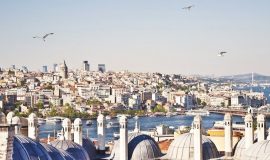


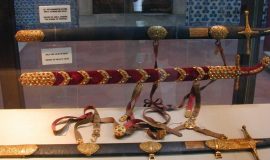
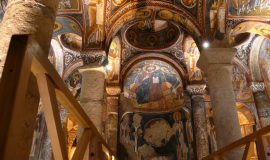


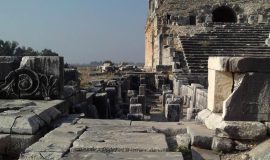
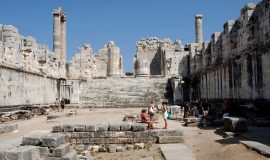
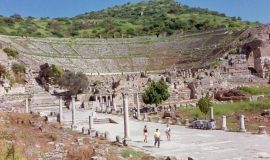
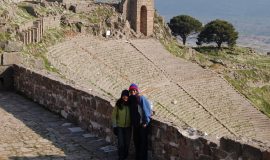

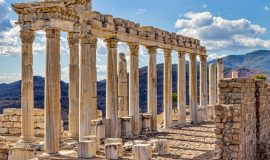
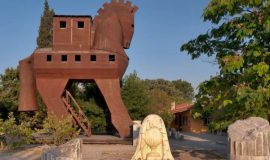

 Izmir
Izmir











